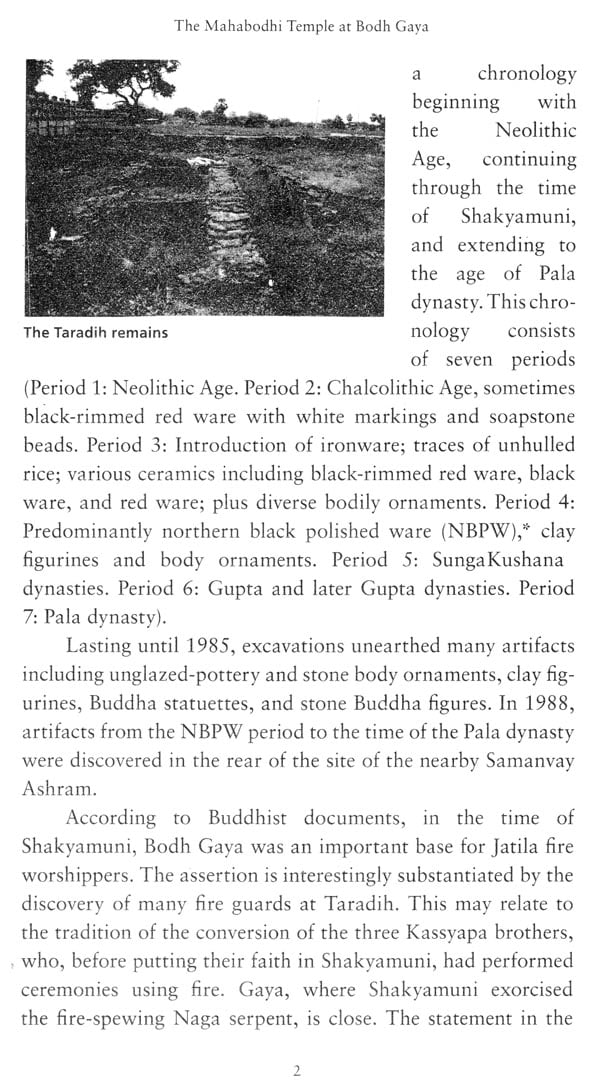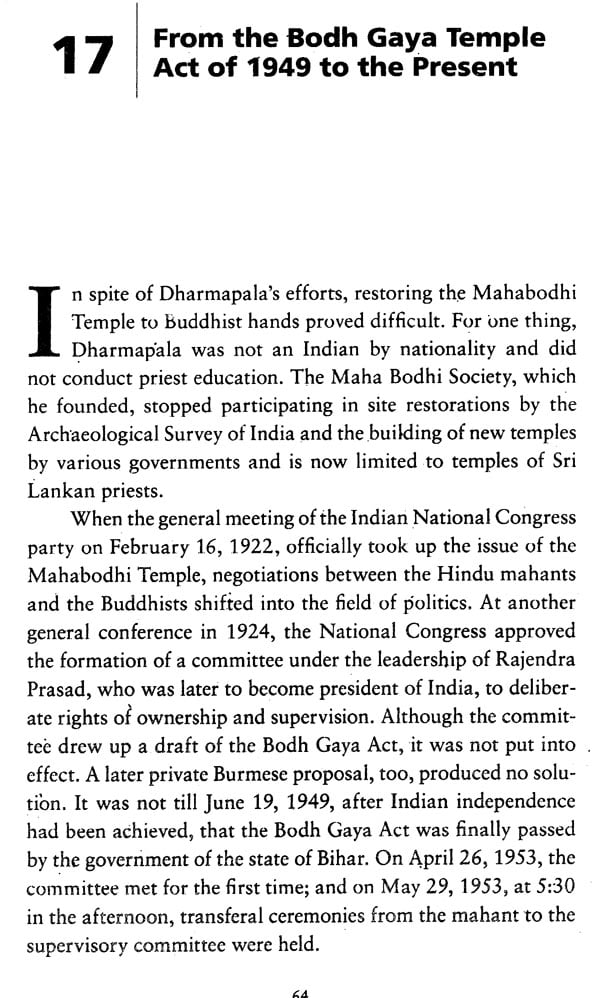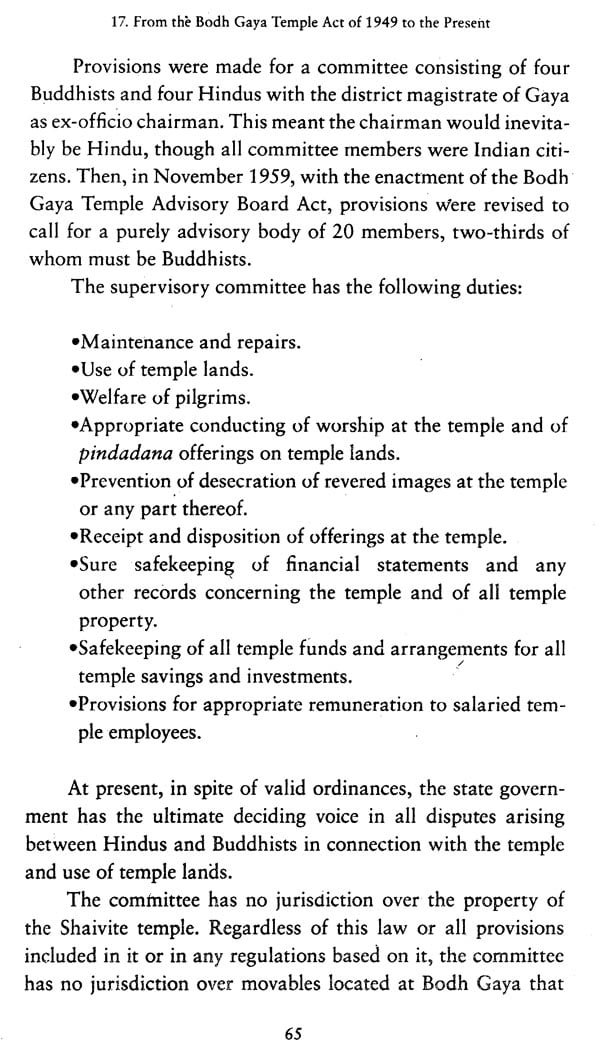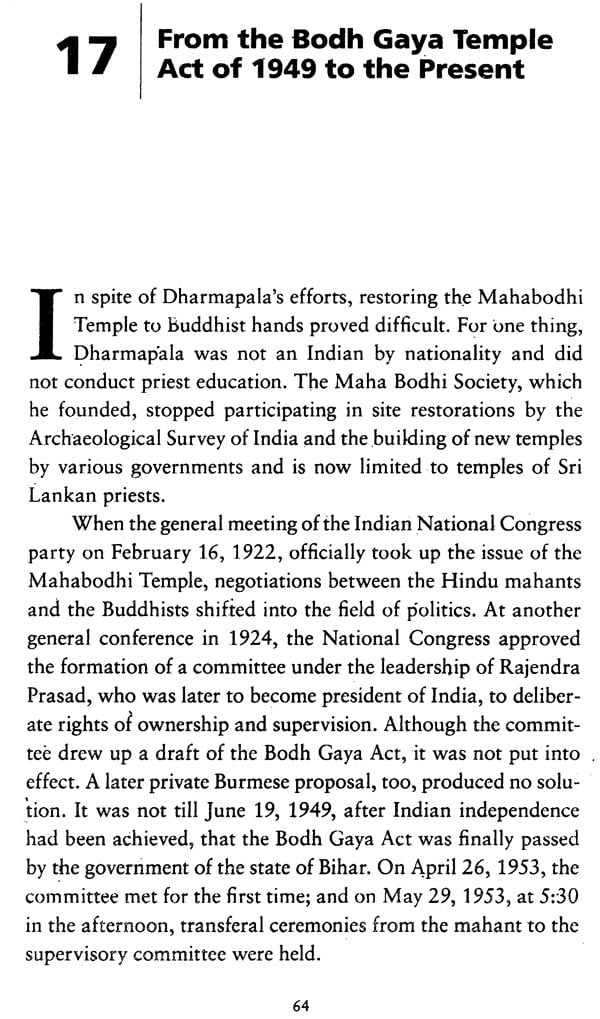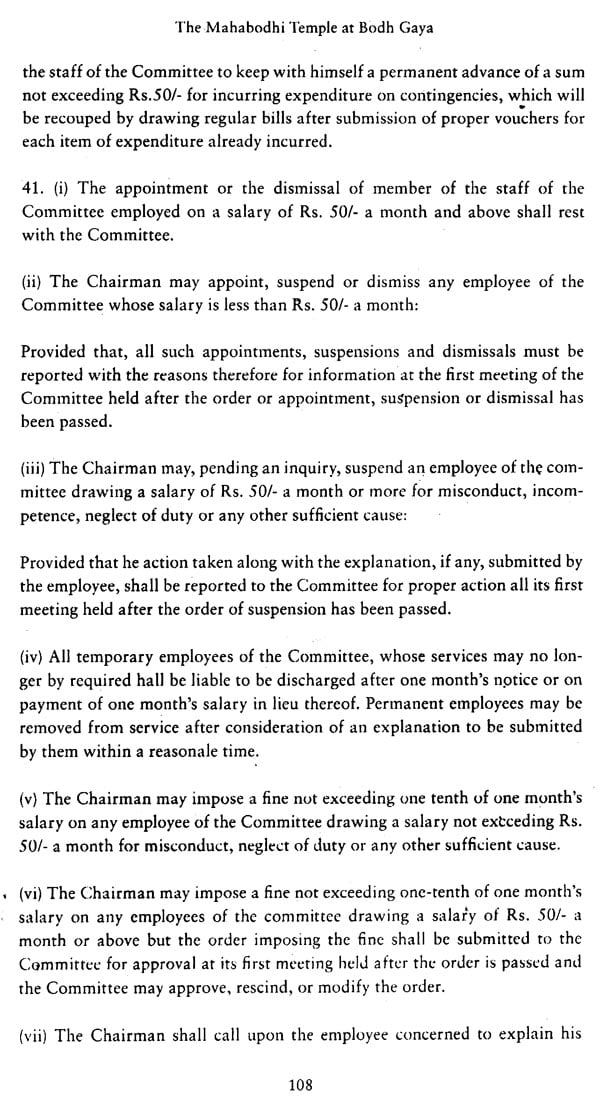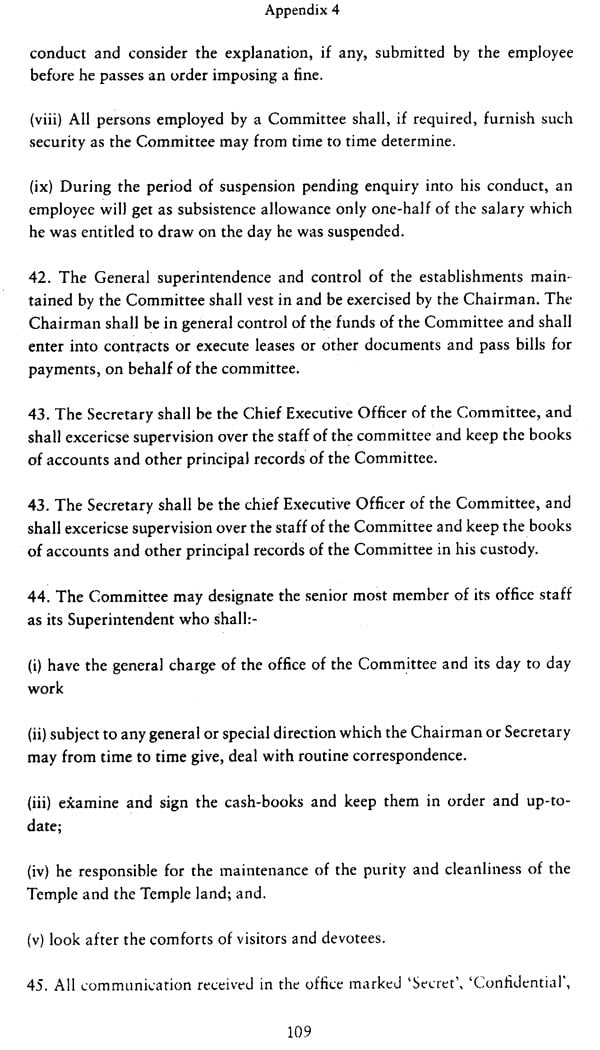
The Mahabodhi Temple at Bodh Gaya
Book Specification
| Item Code: | NAT427 |
| Author: | Ryojun Sato |
| Publisher: | Motilal Banarsidass Publishers Pvt. Ltd. |
| Language: | ENGLISH |
| Edition: | 2014 |
| ISBN: | 9788120839434 |
| Pages: | 124 |
| Cover: | HARDCOVER |
| Other Details | 9.00 X 6.00 inch |
| Weight | 280 gm |
Book Description
The Mahabodhi Mahavihara which stands majestically identifying the spot of the Buddha's Enlightenment is not only an artistic edifice but is also a place of worship where people and practitioners have immense faith and belief and is also a cultural landmark which identifies itself with the message of the master with that of love and compassion, equanimity and sacrifice, unity and brotherhood. People, believers, practitioners and adherers all come at Bodh Gaya to offer their venerations not only to the sacred Bodhi Tree or the Vajrasana or the Temple itself but come here for meditation and seeking that illusive peace and tranquility as the Buddha Himself advised His faithful that at least once in their lifetime one should go on a pilgrimage to the four holy places connected with the life of the Buddha which are Lumbini-where Prince Sidhartha Gautama was born, Bodh Gaya-where Siddhartha Gautama attained Enlightenment to become the Buddha, Sarnath-where the Buddha for the first time preached the Dhammacakkapavattan Sutra or Turning of the Wheel of Dhamma and Kusinagar-where the Buddha entered into mahaparinibbana. Prof. Rev. Ryojun Sato, has done a commendable job by writing on this topic. This book will prove useful to the readers as well as the researchers and scholars to know more about the Mahabodhi Mahavihara and Bodh Gaya as a whole.
a Prof. Emeritus of Taisho University in Tokyo, Japan. e. a so serves as: Chairman, Board of Directors, Meisho Kindergarten, Tokyo; chief priest, Koen ji Temple, Tokyo; Member, Board of Counselors, International Buddhist Brotherhood Association, Bodh Gaya, India; Patron, Bengal Buddhist Association, Kolkata, India; Patron, International Brotherhood Mission, Assam, India.
The Mahabodhi Mahavihara which stands majestically identifying the spot of the Buddha's Enlightenment is not only an artistic edifice but is also a place of wor-ship where people and practitioners have immense faith. and belief and also is a cultural landmark which identifies itself with the message of the master with that of love and compassion, equanimity and sacrifice, unity and brotherhood.
People, believers, practitioners and adherers all come here to offer their venerations not only to the sacred Bodhi Tree or the Vajrasana or the Temple itself but come here for meditation and seeking that illusive peace and tranquility, as the Buddha Himself advised His faithful that at least once in their lifetime one should go on a pilgrimage to the four holy places connected with the life of the Buddha which are Lumbini-where Prince Siddhartha Gautama was born, Buddhagaya-where Siddhartha Gautama attained Enlightenment to become the Buddha, Sarnath-where the Buddha for the first time preached the Dhammacakkapavattana Sutra or turning of the wheel of Dhamma and Kusinagar-where the Buddha entered into mahaparinibbana. His advice to His followers to go on a pilgrimage was much as to gather inspiration for their practice but at the same time was an occasion to meet many more monks and other faithful from whom one could share their experiences and learn more about the Dhamma.
One of the earliest pilgrims who came here to visit the place after the Buddha's demise was none other than King Asoka the Great (273-232) of Pataliputra which happened 250 years after the Masters demise. This visit brought glamour, importance, state sponsorship and laid the foundation of this place when he constructed the Vajrasana and a Stupa marking the spot of the Buddha's Enlightenment. Prior to his visit it is recorded that Kurangi and Nagadevi had constructed railings around the Bodhi Tree. But it was the visit of Asoka and his subsequent visits that made this place important in the annals of history.
The present Mahabodhi Temple was built in the 2nd century AD and built over the original stupa constructed by King Asoka. It was during the Gupta reign that the magnificent Temple was completed in around 7th century AD. The awe generating gilded statue that we see inside the shrine room was made some time in the year 380 AD. It is made of black stone and painted in gold which is of recent practice. Such was the awe generated- from the sublimity of the Buddha statue that when the Noble Laureate Rabindranath Tagore visited the Mahabodhi Temple it was the first time in his life that he felt like bowing his head in front of a statue.
The Bodhi Tree under which the Buddha attained Enlightenment has its own history. Although it is a tree revered and worshipped by the millions around the world, the faithful seek from it solace and peace sitting under its widely spread branches. This tree which stands today is not the original one but is a descendant of the original. It was Asoka's son Mahendra and daughter Sanghamitra who had taken a sapling of this sacred tree to Sri Lanka as a gift from the King Asoka as a token of his admiration for the people of that country and opening a chapter in his foreign policy, it has today become a symbol of our friendship between both the countries. The present tree is the 4th or 5th tree in succession. Although there are myths and legends and here says about the tree over the centuries but this tree remains the cynosure of all eyes and steadfast dedication- and unwavering faith irrespective of nationalities and creeds. No Buddhist can ever dream of causing harm to the tree but will do all that is needed to safeguard the tree and ensure its longevity especially when we know that the life span of the ficus religiosa or the peepul tree is very short but a fast growing tree and easily grows needing not much support or help during its growth. It is a matter of significance that the Bodhi Tree of Anuradhapura has gone on to become the oldest recorded tree in the world.
There is no recorded history in continuity from the earli-est times to the present day. It is the travelogues of Fa Hien or Fu Xian (337-424), Xugn Zang (600-664) and It-sing (671-695) which gives us a vivid picture of the place and time to deconstruct the history of the place, in fact the entire Buddhist landscape. Dr. B. M. Barua's monurnenral work Gaya and Buddhagaya: Early History of the Holy Land in two volumes, Alexander Cunningham's Mahabodhi or the Great Buddhist Temple under the Bodhi Tree at Buddha Gaya, Dr. Rajendra Lal Mitra's Buddhagaya: The Great Buddhist Temple also count amongst the documentation of this place. Prof. Dipak Kumar Barua has attempted with his Buddha Gaya Temple: Its History which deals with the history of the place in detail but the attempt made by Prof Ryojun Sato brings to light the history of this place divided into chapters and giving in detail from multiple sources which makes it for easier comprehension dealing minutely which is not available otherwise.
Buddhagaya has changed a lot over the years and is changing everyday to meet the demands of the times. Although archaeologists will argue that this is an archaeological monument but we should not forget that this is also a living temple where people have immense faith and belief. Due to the increase in pilgrims arrival it is imperative to provide infrastructural support like pathways, toilets, refreshing rooms, meditation places, place to light lamps and incense, space for pujas and a serene environment commensurate with the other religious and spiritual centers. After being declared a World Heritage Property by UNESCO the place started to receive more attention. With the airport coming up at Gaya arrival of pilgrims increased manifold and with better connectivity by road and rail people have far more options to travel than what Was available 15 years back. The township requires infrastructure support like drainage and sewerage, cleanliness and garbage disposal mechanism, pure drinking water, tourist friendly bus and taxi stands, shopping complexes and regulated markets, underground cable electrification. The Administration has to also look into the aspect of local transportation catering to the domestic populace.
Buddhagaya has in the modern period received attention in the year 1.956 when India was celebrating the 250Q Buddha Jayanti whereas it should have been the 2500th Buddha's mahaparinirvana. The celebrations were organized by the Government of India under the leadership of the honourable Prime Minister Pandit Jawaharlal Nehru who advocated the necessity of the Buddha's teachings and revival of the places of Buddhist interest connected with the life of the Buddha. He urged the Buddhist countries to construct Buddhist viharas and monasteries in Buddhagaya depicting their art and archi-tecture, their cultural ethos which in turn would contribute to the cultural legacy of this place. Today we have viharas of all the Buddhist countries which have enriched Buddhagaya into a cultural repository. Alongwith these viharas they brought with them their food habits and clothing, their language and their style. But what is important with this place is that with the advent of the Muslim rule in the 12th century AD Buddhism went into a decline due to man made miseries and then the natures fury.

